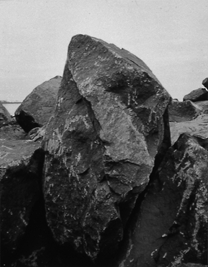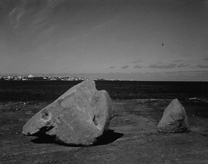| Ívar Brynjólfsson |
 |
 |
|
|
by Jón Proppé
No art form is probably more practical today than photography. Indeed, it is so practical that the majority of those who have studied photography quickly get stuck in commercial photography to earn a living after graduation. They risk loosing the artistic visions that lead them to photography in the first place and become labourers of the media or the advertising agencies, disappointed and frustrated. Many of our best photographers do nonetheless manage to combine their commercial obligations with their artistic visions, yet few are able create large projects - projects of the kind that can lead to good exhibitions. There is also the risk that the values and methods of commercial photography will pollute these artistic endeavours. Photographs that are made for exhibitions or get published in books thus often amounts to little more than slick and artfully executed commercial work. It lacks inventiveness and depth of thought, which is the foundation of all good art.
No Icelandic photographer has fought more vigorously against the temptations of commercial photography than Ívar Brynjólfsson. His exhibitions differ radically from those of his colleagues. In his pictures, structural discipline and clear and original vision goes hand in hand. He picks out difficult subjects and avoids cheap solutions at every turn.
Ívar is occupied with things that the rest of us take for granted. In his last show at Gallery 11, Ívar showed "Pictures from Ordinary Places". It consisted of pictures that Ívar had taken inside houses, mostly in public places, companies and institutions. The pictures showed corners, doors, furnaces and other similar things. They were Spartan in their simplicity and the subject was of little interest as such. But as a whole the series documented a neglected part of our experience - it was a critical survey of our visual surroundings.
Neither the gallery nor Ívar's present exhibition is very large, but since the idea behind the series is exceptionally lucid and the presentation well defined and disciplined, the show conveys its message effortlessly to the audience. The title of the show is "Landscape-Earth Works", and this time around Ívar has chosen as his subject the bedrock and boulders that have been blasted away and indented by heavy machinery; soil torn up by bulldozers and flattened out, landscape which people have invaded and shattered in the heat of the moment. All of the photographs are taken in the city and in most of them we see the city in the background with the boulders resting in the foreground like a testament to the enormous power unleashed by the inhabitants during the construction of the city.
In the leaflet accompanying exhibition, Ívar emphasises that his photographs are not meant as a contribution to the cause "green peace". He could have left that remark out since his pictures have nothing to do with the world of fashion and popular debate or the ecological politics of today. What grabs our attention in these pictures is the artist's strong formal vision, how the images are able to free themselves from their subject and create an independent existence as cohesive and well made works of art.
(The daily newspaper DV, January 10, 1994. Transl. HS)

Landscape - Earth Works
by Gunnar J. Árnason
Images are not limited to people; our whole country has become a defenceless victim of image-making, due largely to commercial photography, and these images are so dominant in our visual culture that one automatically starts to believe in them. Ívar Brynjólfsson's exhibition came thus as a pleasant surprise as his photographs do not seem to fit these standard images of the Icelandic landscape. One is pulled down to earth, so to speak.
Ívar usually aims his lens at places we tend to disregard or simply fail to notice. We usually keep alert to the landscape and the clouds and we pay attention to buildings and structures, but are ignorant of the things that lie somewhere between and belong to neither of these categories. Ívar was working along similar lines in his last show at Gallery 11, except there he focused on our immediate surroundings, "Ordinary Places“ as he called it.
But where are these locations we fail to observe and hence disappear into our environment? They are probably all over the place, but Ívar has kept his eye on the fences and land formations along the Reykjavik coastline. In the foreground we see large boulders that have been dislodged from their original surroundings with dynamite and piled up with bulldozers, as is clearly evident. In the background we see the land on either side of these earth works; the city of Reykjavik on the one hand and the wilderness — mount Esja, bay of Faxaflói and the sky-line — on the other. These land formations are grounded where the organised and fabricated meets the natural and untainted.
This is perhaps not the most attractive subject matter, but if one believes in the beauty of photography one can put that worry aside. It is all the more difficult for the photographer to rely on such an "ordinary" subject. Ívar presents his view with certainty and conviction.
(From the weekly newspaper Pressan, January 27, 1994. Tansl: HS)
 |
|
|
 |
|
|
 |
|
|
|
|
|
|
|
|
|
|